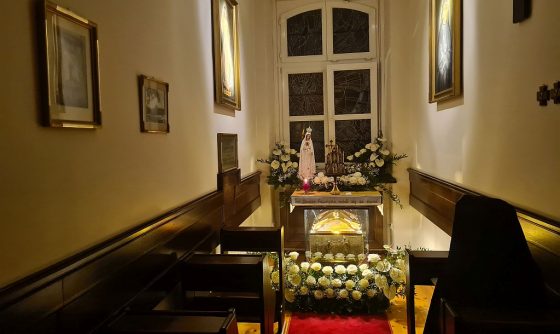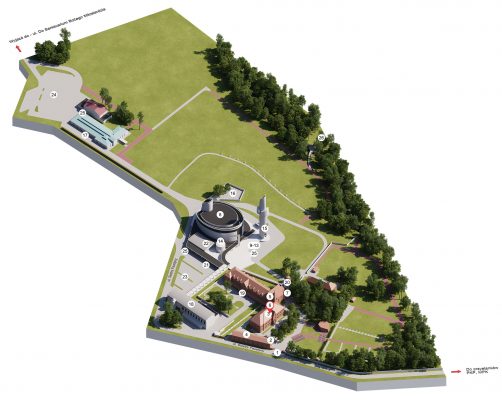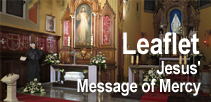We have put a map of the Shrine after the text.
The Oratory is a small, narrow room where Sister Faustina spent the last weeks of her life and at 10.45 p.m. on 5 October 1938 departed for the House of the Heavenly Father. For many years she had been looking forward to this day and longing for it, because she loved God so much and developed such a profound knowledge of His merciful love that she wanted to live with Him face to face for all eternity, without the screen of faith hiding Him from her. On that day in the afternoon Father Andrasz, her Cracovian spiritual director, heard her last Confession, and in the evening the Sisters and chaplain prayed for the graces she needed at the hour of death. The witnesses present at her bedside when she died were Sister Amelia Socha and Sister Eufemia Traczyńska, who desperately wanted to watch a saint dying. Sister Eufemia was inadvertently woken up by Sister Liguoria, who was on duty at the time, and when she and Sister Amelia went down to the infirmary, “Sister Faustina seemed to open her eyes a little and gave a faint smile, then she dropped her head and that was it… Sister Amelia said that she must have just died, she’s passed away. I looked at Sister Amelia but did not speak to her, we just continued to pray. The candle was alight all the time.”
In August 1936, Sister Faustina saw the place of her destiny in Heaven, when her Guardian Angel took her to the throne of God. “I saw a great, inaccessible brilliance, and the place of my destiny near God,” she wrote in her Diary, “but what it is like I do not know, as it was hidden behind a cloud. But my Guardian Angel told me, ‘Here is your throne, for your faithfulness in carrying out the will of God’” (Diary 683). On the day she died she saw that “throne.” Now she sees God face to Face and is perfectly happy.
In one of her early mystical experiences she was allowed to visit the Souls in Purgatory (Diary 20). She saw them suffering and how they longed for God, how they wanted those alive in the world to help them, for only they could support them with prayer, sacrifices, and offering up indulgences for them in the Church’s treasury. The Angel also took her to the abyss of Hell, and she described the dreadful torments sustained by those damned of their own free will, because they had chosen a life and all eternity without God. Most of the souls there are those who did not believe Hell exists. “I, Sister Faustina, have been in the depths of Hell at God’s behest to tell souls that Hell exists and to testify to its existence,” she wrote in her Diary (741), so that no one should use the excuse that they never knew.
She also saw the happiness of the inhabitants of Heaven, and endorsed the words of St. Paul, who asserted that “The eye has not seen, and the ear has not heard, nor has it entered into the heart of man, what things God has prepared for those who love Him” (1 Cor. 2:9). Although the Saints in Heaven are perfectly happy, they still have the opportunity to take action. They are worshipping God, yet they are also interceding for the Church Militant in its pilgrimage on Earth. There is a mutual exchange of gifts going on between the faithful on Earth, those suffering in Purgatory, and those who are happy in the glory of Heaven. This truth of the faith made Sister Faustina deeply convinced that after death she could work even more good, and so she made the following declaration: “I shall not forget you, O poor Earth, though I feel I shall immediately sink completely in God, as in an ocean of bliss; but it will not prevent me from coming back to Earth and fortifying and encouraging souls to trust in Divine mercy. In fact being submerged in God will give me unlimited scope for action” (Diary 1582).
Today this little room serves as an oratory (a place for prayer) and holds a reliquary designed by Gustaw Zemła with a handful of the ashes collected from St. Faustina’s mortal remains in the little coffin under the altar in the chapel, as well as relics of over a hundred saints and blesseds. The oratory may be entered only from enclosure, so pilgrims may visit it only once a year, on 5 October, the anniversary of the death of the Apostle of the Divine Mercy.
- Main entrance to the Shrine
- Sister Faustina’s House: hotel & museum
- Convent
- Antoninek House: Faustinum Association
-
Merciful Jesus Chapel & Saint Faustina’s Tomb: Heart of the Shrine
- Oratory: room where Saint Faustina died
- Chapel of the Lord’s Passion
- Divine Mercy Basilica
- Saint Faustina’s Chapel
- The Communio Sanctorum Chapel
- Saint Andrew’s Chapel
- The Holy Cross Chapel
- The Chapel of Our Lady of the Seven Sorrows
- Perpetual Adoration Chapel
- Viewing Tower
- Convent Graveyard
- Sister Faustina’s House: restaurant, souvenirs & meeting hall
- Pastoral Lodge: hotel & restaurant
- Mercy House
- Information Booth
- Souvenirs & Misericordia Bookshop
- Saint John Paul II Hall
- Car park
- Car and coach park
- Toilets
- Bridge of Mercy, for the Saint John Paul II Shrine & tram stop

















